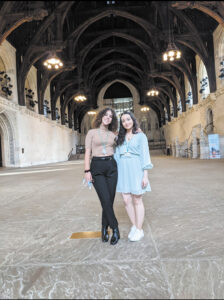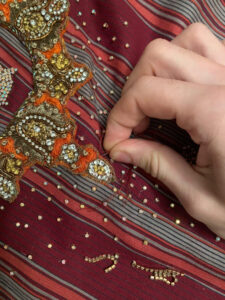Our greatgrandparents lived in a circular economy, upcycling items of clothing, a practice a new project hopes to encourage people to replicate. ALIX NORMAN meets the people behind the island’s latest fashion initiative
There are plenty of sustainable fashion ventures out there. But the Tsemberi Project is a first for the island: an undertaking that marries fashion sustainability with the rich Cypriot heritage…
Launched in July 2021, Tsemberi sees six young fashion designers from across the island participating in a unique project: the creation of new sustainable, zero-waste designs inspired by Cypriot cultural heritage. Aiming to introduce the local community to alternative or greener ways of purchasing or treating clothes, it’s offering young designers the chance to work collaboratively, and at the same time promote their work through exhibitions, social media campaigns and short films.

“This is the first fashion sustainability project in Cyprus to focus on Cypriot heritage,” explains Christina Dymiotis, who with co-founder Anastasia Filippou created the Project. “Fashion sustainability and the circular economy were once significant aspects of Cypriot heritage: our great-grandmothers and fathers didn’t toss out clothes or fabric; they simply upcycled each item into something new. That’s the idea we want to re-introduce,” she explains. “But this time, it’s less about being thrifty and more about minimising clothing waste, which has a negative impact on our environment.”
The notion of fashion sustainability is deeply embedded within Cypriot heritage, suggests Christina, and will be familiar to most. “So Tsemberi will, we hope, give people the opportunity to reflect on their current purchasing habits, rethink the way in which they treat their clothes, and provide space for the adaptation of fashion sustainability tactics. Really,” she adds, “the question is simple: ‘If our ancestors were sustainable, why can’t we be too?’”
For the past 10 months, the six designers involved in the Project (Leandros Farley-Stamadiades, Mert Özyürekliler, Irene Panayi, Diamando Skannavia, Michalis Pantelidis and Petros Kourtellaris) have been sourcing, cutting, recreating and embellishing fabric – transforming old garments and materials into something entirely new, yet with a twist of heritage.
“Our fashion designers,” explains Anastasia, “have used only second-hand fabrics and zero-waste techniques to minimise their fashion waste. They’ve also implemented wonderful eco-techniques such as natural fabric dying. Many of the fabrics used are of the traditional Cypriot type: latzia and lefkaritiko (lace). And one of our designers, Leandros, used fabrics his grandmother had owned from a young age – an amazing chance to showcase this wonderful find to the world!”
A collaboration with the Royal Commonwealth Society, Clarion Futures in the UK, and Fashion Revolution Cyprus, the Project will culminate in a public exhibition, held at the headquarters of the Stelios Philanthropic Foundation, Nicosia, on May 7 and 8.
The 23 young Cypriots in the team (including those involved in marketing, coordination and event curation who are working remotely from all over Europe) have been supported, from the outset, by a great number of people and organisations. “And we will be forever grateful for their time and efforts,” says Christina. “Among these are the British High Commission in Cyprus, the Commonwealth Fashion Council, Cyprus Inno, Home for Corporation, University of Cyprus, Frederick University, Circular Economy Alliance and the Nicosia Municipal Arts Centre (NiMAC).

“It’s a testament both to the idea and the designers that we have found so much support,” she adds. “It’s certainly no secret that in Cyprus young people in the arts sector do not always have many job opportunities. So the Tsemberi Fashion Project is acting as a valuable platform for young Cypriot fashion designers, allowing them to showcase their work via social media campaigns and short videos, and providing them with the opportunity to see their work appear in public exhibitions, where they will be able to network with industry professionals.”
During the course of the Project, the young designers enjoyed the chance both to attend meetings with local sustainable fashion designers and in-person fashion workshops, and have also had their work shared with the Commonwealth Fashion Council, a global fashion network. And many have no doubt learnt a great deal about their own heritage, and the sustainable practices used by their forebears.
“Our grandparents’ generation was a zero-waste, sustainable culture for the most part,” says Christina. “The majority of the population had very little. Clothes were generally made to last: our ancestors would take care of their garments. Unlike the disposable fashion of today, they appreciated and valued what they had. Sustainability practices such as reusing and upcycling were common, as was mending: clothes and shoes to be repaired by the craftsmen and women of the area, further supporting the local economy.”

Tsemberi references this circular, community economy not just in its ideology, but also in in its name: ‘tsemberi’ in Greek is the traditional women’s headscarf, circular when worn. “We wanted to select a name that was understood by all the communities in Cyprus,” explains Anastasia. “The word itself originates from ‘Çember’, meaning ‘circle’ in Turkish. And this greatly resonated both with the circular nature of our project and our attempts to reinforce the inter-communal aspect of Cypriot heritage.”
Drawing inspiration from the circular economy, community and culture, the Tsemberi Project hopes to remind us that sustainability was once prevalent on the island. And, at the same time, to encourage people to re-adapt these essential sustainability practices for modern-day life.
“At the exhibition, you’ll find sustainable designs specifically inspired by everything from lefkaritika to worker’s garments, and both the design and colours of the Cypriot saya (the traditional dress). Everything,” Anastasia reiterates, “has been created using second-hand or found fabrics.”
“Re-using, upcycling, swapping and buying second-hand are less wasteful and more sustainable strategies when it comes to fashion,” says Christina. “So is the idea of valuing our clothes: treating them better so that they last. Fashion waste is a real problem nowadays,” she concludes. “With the Tsemberi Project, we hope to remind people that loved clothes last – and can often become something entirely new!”
The Tsemberi Project exhibition is open to the public, and will take place at the at Stelios Philanthropic Foundation Headquarters in Nicosia on May 7 and 8. Entrance is free. For more information, visit the Facebook page Tsemberi Fashion Project or the Instagram account @tsemberi


